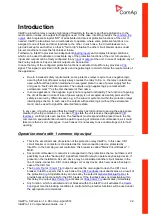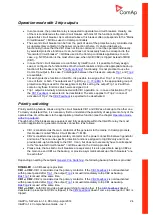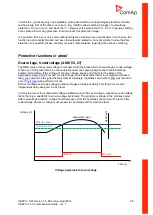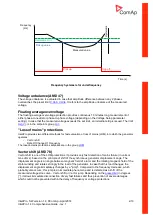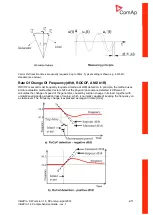
InteliPro, SW version 1.4,
©
ComAp
–
April 2014
InteliPro 1.4 Comprehensive Guide - rev. 1
2-16
This protection functionality uses the fact that voltage in the point of short-circuit drops to zero or very
low values and with growing distance from the fault, it increases up to the mains nominal voltage
value. Thus, increased sensitivity to short-circuits localization and protection coordination is provided.
The setting is done using the setpoints in the group
Earth Fault Current (ANSI 50N, ANSI 51N)
For the earth fault current protection, the 5 A current measurement input, located on the plug-in
module
is used. The protection stage allows setting up instantaneous neutral
overcurrent or IDMT overcurrent, similar to the mains overcurrent protective functions. The setting is
done using the setpoints group
Ground Surge Current (ANSI 50GS, ANSI 51GS)
The function is intended for detection of non-zero current used to indicate earth faults by sensitive
ground sensors. The function enables very sensitive measurement in level up to 50 mA, so it is
applicable e.g. for Hall sensors measurement. Please note, that due to very low measurement range,
it must be assured that the current will not overreach 120mA, what is the thermal capacity of the input.
For the ground surge current protection, the 50 mA current measurement input, located on the plug-in
module
is used. The protection stage allows to set up instantaneous ground
surge overcurrent (ANSI 50GS) or IDMT overcurrent (ANSI 51GS), similar to the mains overcurrent
protective functions. The setting of the 50GS/51GS function is done using the
Unlike the mains current or earth fault current protections, the limit setting is done directly in mA.
Current unbalance (ANSI 46)
The current unbalance protection is used to avoid unbalanced load in the point of mains connection.
The setting is done using the setpoints in the setpoint group
. The units of
current nominal value.
Directional overcurrent (DOC, ANSI 67)
DOC is sensitive for location of the fault with relation to the measurement point. This way, directional
protection is capable to detect whether the fault happened "in front of it" or "behind". Directional
overcurrent protection, applied in the point of generator connection to mains, is considered a loss of
mains protection, however it does not substitute the traditional loss of mains protections like
. The typical application is a generator running in parallel to mains with its own load
consumption (e.g. peak shaving, soft transfer stand-by, or other applications). The generator is usually
used to support the local consumption with no export to the mains. In case of mains transition into an


